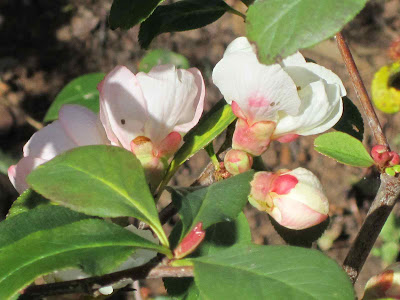Zig Ziglar. In case the name doesn't ring a bell, he was one of the very first motivational speakers. I saw Zig Ziglar in person in the late 80's. It made an indelible impression.
My white irises are the Zig Ziglar of my garden. They seem to have taken some of his motivating messages to heart:
- 1) Bloom where you're planted.
Zig Ziglar tells of a woman that came to him and said she hated her job. He advised her to make a list of all she liked about her job, and for several weeks, to read that list daily. It changed her attitude, and she began to appreciate her work.
Winter is not the easiest of times for a gardener to get through. But my white irises are one of the first to bloom, heralding in spring from the dead of winter. They immediately change my attitude to a positive one. And every day as the blooms increase, so, too, does my joy, and my desire to work.
- 2) Be proud of yourself and what you do.
Zig Ziglar never said "I'm just a salesman." Instead, he would explain that each sale would generate jobs for people to produce the product, accountants to count the money, and bankers in which to deposit the funds. The bankers would then lend out a portion of that money, and people would acquire homes, automobiles, and other products, all of which require jobs for people in construction, automobile manufacturing, and other lines of production. New furniture would be needed for the home, gas for the car, etc., requiring more people to fill jobs at furniture companies, gas stations, oil companies, and many more. The people in these jobs would get paid, generating jobs for even more accountants, and even more bankers. And it goes on and on. All because he made a sale.
My white irises are proud, too. Tall and stately, these have weathered the storms that have come their way, and still hold their heads high. Even when their stems are broken, they bloom anyway. That's determination! When they start blooming, it seems to encourage my other plants to start blooming, too. My garden begins to come to life, and it all starts with my white irises.
Another lesson from Zig Ziglar was to give others an honest compliment. After we listened to him speak, we went to a little cafe for dessert and coffee. We took Zig Ziglar's lesson to heart and not only tipped the waiter, but wrote little heartfelt compliments to him on our napkins. It made us feel happy, and I hope it made him happy, too.
Want a complimentary plant? The spiky foliage of irises make a great compliment to other plants. Whether they're in bloom or not, I think irises are a wonderful companion plant to have in the garden all year long.
My white irises. They're blooming now. I can almost hear them giving my garden a motivational speech!
















































